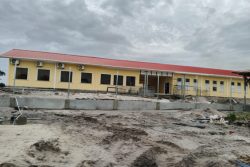The designation of May 3 as Portuguese Arrival Day – to commemorate the 1835 docking, in Demerara, of the Louisa Baillie from Madeira – is a welcome gesture of inclusivity and an overdue acknowledgement of our diversity. Descendants of the 40 Madeirans who landed that day have gone on to shape this country in countless ways, not least through their stalwart support of the Catholic church, schools and charities. But as President Granger, a scholar of African-Guyanese history, must have known, any gesture towards the past, however well-intentioned, is likelier to provoke questions than provide answers. In a multicultural society, the invocation of arrival stories quickly devolves into difficult conversations about who deserves what, who suffered more, and who gets to decide how our collective history is told, interpreted and celebrated.
In “The El Dorado Complex in the Shaping of Indo-Guyanese” a 2014 Republic of Guyana Distinguished Lecture, Prof Clem Seecharan, Emeritus Professor of History at London Metropolitan University, cites the following insight by Indian psychoanalyst Sudhir Kakar: “The fictions we tell ourselves about our past and our lives,” writes Kakar, “are indispensable to keep at bay the truth that may shock us out of our ever-precarious sense of well-being and self-worth‟ Seecharan carefully demonstrates how “Amnesia and fantasy are at the fount of the construction of Indo-Guyanese identity.” He traces how elements of both informed an arrival myth within the Indo-Guyanese community that used religious and folk sources to accommodate a profound ambivalence towards the country they had left behind and their delicate position within their new homeland.
Seecharan notes that “because of African repugnance to indentureship, it was difficult for Indians in the colony to erase the stubborn lore that they “took bread out of the mouths‟ of Africans. Consequently, probably defensively, they would continually deny agency for their migration to the colony, attributing it to kidnapping, trickery, to being duped into journeying to distant lands.” He also points out that only 5 or 6 per cent of the newcomers were south Indians, the mast majority coming from the “impoverished eastern districts” of Uttar Pradesh (70.3 percent) and the “contiguous, equally poor, western districts of Bihar” (15.3 per cent).
Elsewhere, Prof Seecharan remarks on our collective need for “myth to provoke effort” – whether through images like Walter Rodney’s unforgettable description of what it took to make our coastline habitable (slaves moving “100 million tons of heavy water-logged clay with shovel in hand, while enduring conditions of perpetual mud and water”) or some other recollection of titanic ancestral struggle. These narratives are inspirational within their respective communities but we have yet to find a way of integrating them into a larger, collective story. This uneasiness with arrival stories is symptomatic of larger problems that surface in postcolonial societies.
In an introduction to the second edition of Imagined Communities, his magisterial survey of nationalist thought, Benedict Anderson notes the New World origins of modern nationalism and comments that the book was written at time when there was a certain “unselfconscious [Eurocentric] provincialism” in the ways that many scholars assessed nationalist movements in countries like Hungary, Poland and Greece. Anderson remarks that this tendency remained “quite undisturbed” twenty years after the book’s publication. Many of the most important works of West Indian historiography were written in response to this provincialism, but that did not make them impervious to parochialisms of their own.
In Africa, the scholar Paul Nugent has noted that nationalist narratives were heavily skewed by political elites who were eager to underscore their importance in attaining independence. When, however, scepticism towards the “dependency paradigm” grew during the 70s and 80s many of these stories were revised to represent earlier triumphs as deceptive preludes to mere “flag independence” which was now revealed, more often than not, as a smokescreen for neo-colonialism. There was comparable scepticism in the Caribbean. In 1980, CLR James told a Grenadian audience that Maurice Bishop and Michael Manley were pioneering a “new orientation” in the region. Meanwhile, other states continued “drifting along just as they were.” “They have flags of independence; they have prime ministers; they have national anthem, butt they are still economically and socially structured as colonial territories.”
James’s point – regardless of one’s political sympathies – is well made. Flags and anthems can only take us so far in the absence of genuine social and economic transformation. Our energies would be better used solving the problems of the arrived than revisiting the circumstances of their arrival. There is also the question of how relevant these narratives are to the large number of mixed-race Guyanese and West Indians. Derek Walcott’s Shabine memorably says “either I’m nobody or I’m a nation” – a line that is far truer to the fertile confusion of our postcolonial reality than the burnishing of separate ethnic narratives. Three centuries before Walcott, Daniel Defoe looked through the other end of the telescope at “that Het’rogeneous Thing, An Englishman:/In eager Rapes, and furious Lust begot,/Betwixt a Painted Britton and a Scot.” Defoe mocked this “Mongrel half-bred Race” with “neither Name nor Nation, Speech or Fame” and pointed out that it has blended with Saxon and Dane, before “heir Rank Daughters, to their Parents just,/ Receiv’d all Nations with Promiscuous Lust.” Once all the mixing had taken place, however, the resulting “nauseous brood” prided itself on its racial purity, its “Englishness.” In an era of increasingly dark nationalisms, surely it is time to move beyond their mistaken simplifications, as well as ours.







